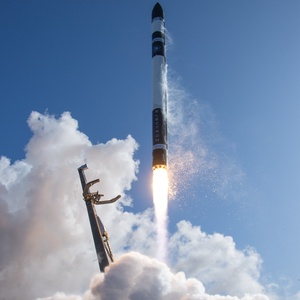Second of three launches of a StriX satellite as part of Synspective’s SAR constellation. StriX-1 can gather high resolution Earth observation data regardless of conditions or daylight, offering a resilient and effective resource for the purposes of urban development, infrastructure monitoring, and disaster response.
Launch trajectory and telemetry simulations provided by Flight Club - a rocket launch simulator and orbital trajectory visualiser for all things space!
Electron is a two-stage orbital expendable launch vehicle (with an optional third stage) developed by the American aerospace company Rocket Lab. Electron is a small-lift launch vehicle designed to launch small satellites and cubesats to sun-synchronous orbit and low earth orbit. The Electron is the first orbital class rocket to use electric-pump-fed engines, powered by the 9 Rutherford engines on the first stage. It is also used as a suborbital testbed (called HASTE) for hypersonics research.
See Details
Booster was expended during its first launch.
Core will be expended.Rocket Lab is an American aerospace manufacturer with a wholly owned New Zealand subsidiary. The company develops lightweight, cost-effective commercial rocket launch services. The Electron Program was founded on the premise that small payloads such as CubeSats require dedicated small launch vehicles and flexibility not currently offered by traditional rocket systems. Its rocket, the Electron, is a light-weight rocket and is now operating commercially. The company is also producing a variety of spacecrafts and spacecrafts components.
INFO WIKIRocket Lab’s 30th mission delivered the StriX 1 radar imaging satellite into orbit for the Japanese Earth observation company Synspective, beginning the deployment of a constellation of 30 commercial radar satellites planned over the next …
Rocket Lab successfully launched a Japanese radar imaging satellite Sept. 15 as the company prepares for another attempt to recover and reuse a booster.
Rocket Lab has made the company and the Electron rocket’s 30th flight. “The Owl Spreads Its Wings,” the company’s third dedicated flight for Japanese company Synspective, launched to Sun-synchronous orbit (SSO) on Thursday, Sept. 15, lifti…
A batch of 20 satellites for the Starlink mega-constellation - SpaceX's project for space-based Internet communication system.
3 weather satellites performing atmospheric measurements using GNSS Radio Occultation for a Tianjin based company. Constellation is planned to have a…
Maiden Flight of the Ariane 62 launch vehicle, carrying ten cubesats, two deployers, five experiments, and two reentry capsules.
Türksat 6A is Turkey's first domestically manufactured geostationary communications satellite. It is to reside in 42° East orbital slot, providing se…
A pair of satellites officially described as for cartographic surveying purposes, details TBD.
Fifth flight of the Firefly Alpha small sat launcher, carrying eight cubesats for NASA's ELaNa 43 (Educational Launch of a Nanosatellite) mission.
A batch of 20 satellites for the Starlink mega-constellation - SpaceX's project for space-based Internet communication system.
The Advanced Land Observing Satellite-4 (ALOS-4) is a Japanese satellite designed to observe the Earth's surface using a phased array type L-band syn…
Chinese communication geostationary satellite for unknown purposes.
Second batch of satellites for a reconnaissance satellite constellation built by SpaceX and Northrop Grumman for the National Reconnaissance Office t…